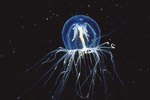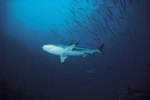
Roughly 4,500 species of dragonfly exist, belonging to the taxonomic suborder Anisoptera. Fossil evidence has shown they're amongst the oldest insects on Earth, and existed more than 300 million years ago. They may have managed to survive on this planet for so long due to some of their many adaptations.
Need For Speed
Well known for their speed, dragonflies can move forward at a rate of roughly 100 times their own body length each second, sometimes reaching speeds of around 55 miles per hour. They're also able to move backward, sideways and on a diagonal, albeit more slowly. Their speed and agility mean they can quickly zoom away from and outmaneuver any potential predators. It gives them an advantage when hunting for prey, too.
Dinnertime
When it comes to eating, dragonflies have a number of adaptations that help them out. They're generalist feeders; although they usually eat insects, they'll chow down on anything they can capture. Since they're not fussy, there's more food available to them. Their three pairs of legs, positioned on their thorax, act as nets to help them catch prey while flying. Their front two legs are slightly shorter, so they can use them to eat with and still remain on the go.
Seeing Clearly
Dragonflies have extremely large eyes for their size, covering the majority of their heads. These are compound eyes, with each one made up of almost 30,000 individual units, known as ommatidia. Although not thought to be quite as effective as that of any vertebrate, these creatures have very good eyesight. They're thought to be able to see in color and have a 360-degree field of vision. They use their stereoscopic vision while hunting, to estimate their distance from prey. Their sharp eyesight may also help them avoid predation.
Nymph Adaptations
It's not just adult dragonflies who are adapted to their environment, their larvae -- or nymphs -- have a range of specializations, too. Since nymphs live in the water, they need to use gills to breathe. They pump water over gills located in their rectal chamber. They can also rapidly release water from this chamber, which quickly propels them forward to escape predators or catch prey. They have modified mouthparts known as facial masks. This is comprised of a hinged lower lip with grasping parts, which they use to help catch their dinner.
References
- Life in Fresh Water: Dragonflies
- Elementary Science Program: Dragonflies
- Animal Diversity Web: Anisoptera
- University of California at Berkeley: Introduction to the Odonata
- St. Mary's College, Broome: Dragonflies
- Texas A&M University: Adaptations of Insects
- Brisbane Insects and Spiders: Dragonfly's Eyes
Photo Credits
-
Ablestock.com/AbleStock.com/Getty Images



